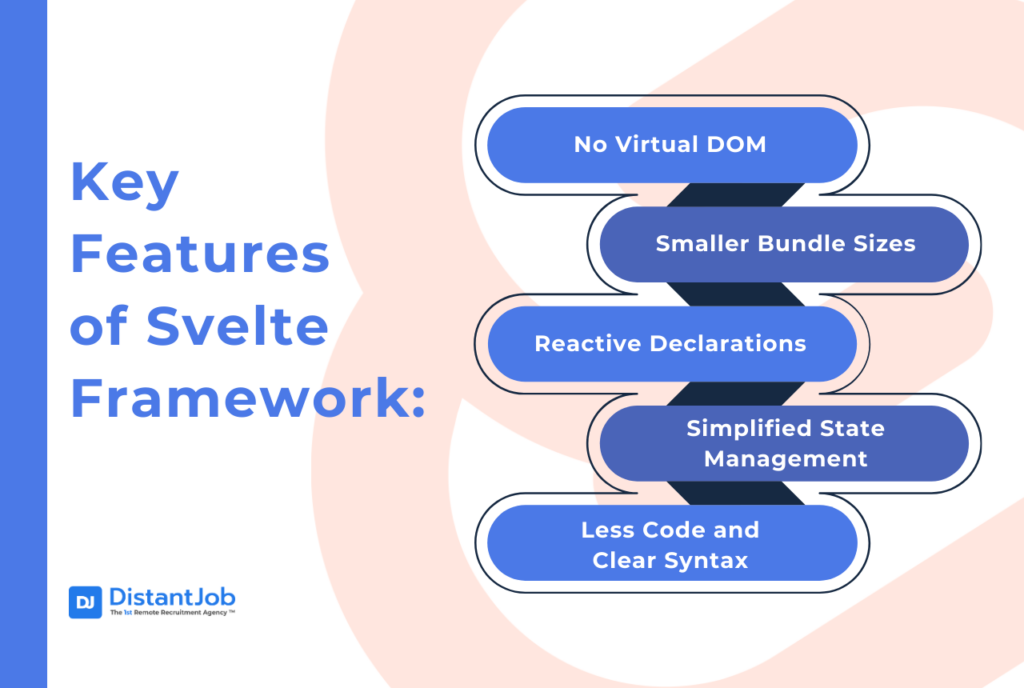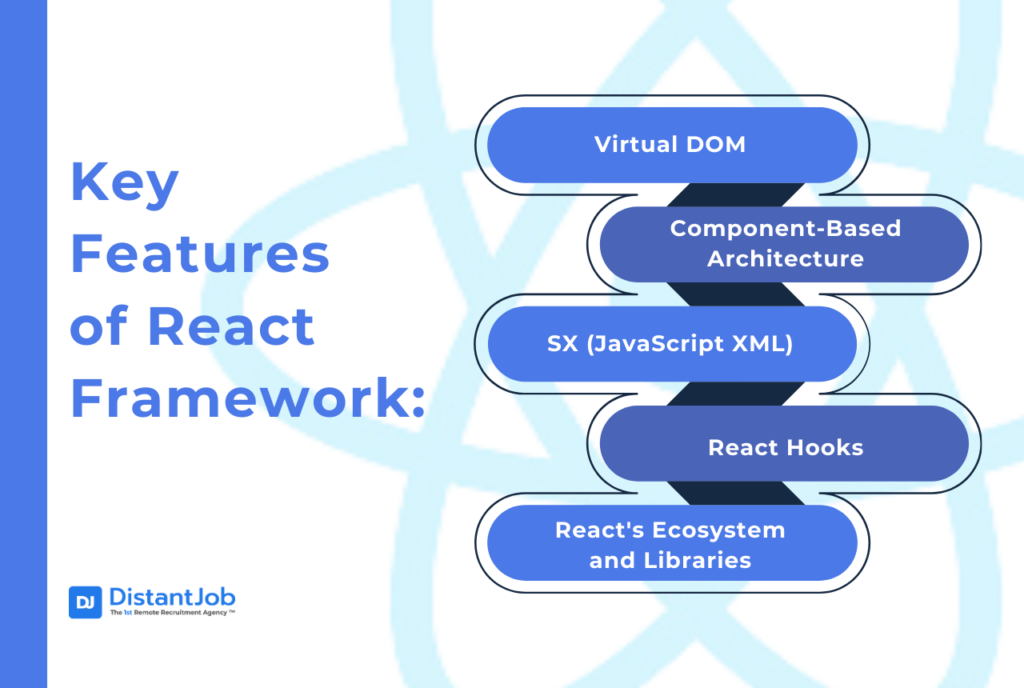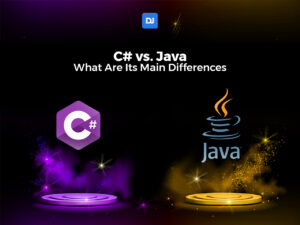Svelte and React stand out as two top JavaScript frameworks for building modern web apps. They both help coders create lively and quick-to-respond interfaces, but they work differently . Svelte is a compiler that makes super-efficient code when you build your app, while React uses a virtual DOM to change UI parts. But, since they’re both great, which one should you pick for your project in 2024?
As more companies move online and web apps get more complex, people want better ways to build them that work well and can grow. How fast a website loads and how good it feels to use have become super important to keep users around and rank higher in search results. This pushes coders to look for frameworks that are both fast and flexible. React is still used by tons of people, but Svelte has gotten a lot of attention as it runs faster and makes smaller files. The State of JavaScript survey shows that more and more coders like Svelte as a new option compared to older frameworks.
In this article, we’ll take a close look at how Svelte and React compare, focusing on how well they work, what features they have, and what it’s like to use them. Whether you’re trying to decide which framework to use for your next project or just want to know what’s new in the coding world, this guide will give you the info you need to make the right choice.
Svelte: The Compiler That’s Changing How We Build Modern JavaScript Apps
Svelte is shaking up web app development by getting rid of the virtual DOM. React compares changes through a virtual DOM while the app runs, but Svelte turns your app into streamlined JavaScript code when you build it. This approach lets Svelte work with the DOM, which means less overhead when the app runs, less memory use, and faster loading times. These improvements matter for apps that need to perform well, like websites made for mobile devices or those running on less powerful hardware.
A Look at Svelte Framework
Svelte, which Rich Harris created in 2016, takes a different path to building UIs. While React and Vue rely on virtual DOM diffing to update the UI, Svelte shifts most of this logic to the compile stage. As a result, the framework produces very optimized low-level JavaScript that can change the DOM.
This difference makes Svelte very effective, as it doesn’t need the runtime overhead to manage a virtual DOM. Instead when a Svelte component’s state changes, it updates the DOM without redrawing the whole component tree. This directness leads to quicker interactions in cases where frequent state updates are needed such as animations or interactive forms.
Also, Svelte helps developers build apps that load fast and don’t hog resources. This makes it useful for phones and other devices that don’t have a lot of power where speed matters a lot. Svelte doesn’t need a virtual DOM. Instead, it turns components straight into super-efficient JavaScript. This means the code runs faster and takes up less space. You can see the difference in apps where being quick and not wasting resources is a must. This is true for people using phones or slow internet connections.
From a developer’s view, Svelte makes building apps easier. It cuts down on the need for complex tools to manage state and avoids the tricky parts of handling a virtual DOM. Also, coders can write in standard JavaScript, HTML, and CSS. They don’t have to learn JSX syntax, which frameworks like React require. This means teams without much experience in complex frameworks can still use Svelte. Svelte does a lot of the hard work during the compile stage. This lets developers zero in on their app’s logic and features. For teams with tight schedules or smaller projects, this streamlined method makes Svelte an attractive and productive choice.
Key Features of Svelte

1. No Virtual DOM
Svelte’s main breakthrough is doing away with the virtual DOM. Instead of comparing and updating a virtual copy of the DOM while the app runs, Svelte turns your app’s parts into streamlined direct code that changes the DOM right away. This cuts down on processing work and speeds up changes, which helps apps with moving or often-changing screens, like dashboards and data picture tools.
The New York Times uses Svelte to create interactive data pictures letting them make quick-reacting and high-performing graphics for their stories. By skipping the virtual DOM, they get smoother interactions even with big sets of data.
2. Smaller Bundle Sizes
Because Svelte turns the framework itself into compiled code, the resulting JavaScript bundles are way smaller than React or Vue. A basic Svelte app can be just a few kilobytes making it ideal for apps where speed matters. This smaller size is key for mobile users who have limited data or slower internet.
IKEA uses Svelte to create its global page templates, which are sent as static pages from a headless CMS. The tiny bundle sizes help pages load faster in different parts of the world giving users a better experience overall.
3. Reactive Declarations
Svelte’s reaction model is built into the framework at the language level. By using a simple $: syntax, developers can create reactive values that cause automatic UI updates when the data beneath changes. This makes managing component states less complex and removes the need for outside libraries like Redux, which people often use in React to manage state.
Reactions in Svelte happen at the variable level. This means that the exact part of the DOM affected by a state change gets updated, not the whole component or the virtual DOM. This detailed reactivity works well for apps that need quick UI updates, like live chat apps or stock market screens.
4. Simplified State Management
Svelte comes with tools to handle global or component-specific state. Its ‘store’ system gives developers an easy way to manage shared state across different parts of an app. While React often needs extra libraries for state management, Svelte’s stores are light built into the framework, and need little setup.
Cloudflare has picked Svelte to build many of its internal tools and web apps, ones that need quick development and fast performance. Svelte’s built-in state management lets developers spend more time on app logic and less time setting up complex state systems.
5. Less Code and Clear Syntax
Svelte’s syntax cuts down on extra code. Unlike React, which needs developers to deal with JSX and keep track of component lifecycles, Svelte lets developers write cleaner, easier-to-understand code that’s more like plain HTML, CSS, and JavaScript. This simplicity helps teams work faster and makes it easier to learn so new developers can join in and test out ideas .
Developers like that Svelte doesn’t need extra tools like JSX, Babel, or Webpack setups, which means they can get started much faster. Svelte’s easy-to-use syntax also means that code is simpler to keep up over time, which is key for projects that last a long time.
Svelte’s Growing Popularity
Svelte has gained quick acceptance among developers since its launch. The 2023 State of JavaScript survey shows that Svelte remains one of the most-liked JavaScript frameworks. Developers praise it for its ease of use and speed benefits. React still rules the scene with its huge ecosystem and third-party tools. However, Svelte’s cleaner code and better performance are becoming more popular. This is true for developers working on smaller projects or apps where speed is crucial.
Real-world tests show that Svelte performs better than React in speed and memory use. The JS Framework Benchmark ranks Svelte as one of the fastest frameworks for key metrics like DOM updates and memory use. Svelte’s efficient handling of updates without slowing down the browser makes it a strong option for apps that need frequent state changes such as real-time data dashboards.
React: A Game-Changer for Big, Complex Apps
Facebook created React in 2013, and now it’s a popular open-source JavaScript tool that helps build interactive user interfaces. While some tools like Svelte focus on making things faster at compile-time, React does things. It uses a virtual DOM to update and show components, which makes it perfect for big complex apps. React’s ability to handle changing data and screen updates while the app is running has made it the top choice for big projects. When you need something that works well is easy to maintain, and can be broken down into smaller parts, React fits the bill.
Through the years, React has become one of the most used front-end libraries backed by a huge ecosystem of tools, libraries, and resources for developers. Its adaptability and ability to grow have played a big part in its ongoing success in the world of web development.
A Look at the React Framework
React uses a component-based structure where developers build applications from parts that they can reuse and change. These parts can keep track of their own information and show up in different places in the app, which makes it simple to handle and expand even the most intricate user interfaces.
React’s virtual DOM aims to make user interface updates more efficient. It does this by cutting down on direct changes to the DOM, which can slow things down and use up a lot of resources. Instead, React makes a light copy of the real DOM (called the virtual DOM). It then updates this copy when states change and applies the needed changes to the actual DOM.
Furthermore, its virtual DOM plays a key role in smooth UI rendering for big apps that need frequent updates. React uses a virtual DOM to keep track of changes and update the necessary parts instead of refreshing the whole DOM all the time. This makes React a great pick for large high-performance apps that need quick updates without slowing down. The component-based structure also makes React perfect for code reuse, which not only helps speed up development but also makes it easier to maintain the codebase in big teams or projects with lots of complex features. React’s ability to adapt and grow as an app’s needs change is one of the reasons why developers still love using it to build complex, performance-heavy applications.From a coder’s point of view, React gives a flexible and strong workspace. It lets coders write HTML-like code in JavaScript with JSX mixing both languages. JSX can be tough for new users to grasp, but it makes building parts and organizing the UI easier, so it’s worth the effort to learn. React’s big set of tools, like React Router for moving around, Redux for handling state, and Next.js for server-side work, makes it even more useful. These tools, plus the huge group of helpers and info sources, turn React into a solid framework for coders working on big projects. With Facebook backing it, React keeps getting better, which helps coders find answers, guides, and good ways to work as they handle tricky projects.
Key Features of React

1. Virtual DOM
React’s virtual DOM has a central role in making it run faster. Instead of changing the whole real DOM when something changes, React updates a fake version of the DOM in memory. It then figures out the smallest set of changes and applies them to the actual DOM. This process called reconciliation, helps things run more even with complex UIs and lots of updates.
Facebook, which created React, uses it a lot to manage its ever-changing feed. The virtual DOM allows the platform to handle updates in real time giving users a smooth experience no matter what device or platform they use.
2. Component-Based Architecture
React’s component-based architecture gives developers the ability to split the UI into small reusable parts. Every component contains its own logic, rendering, and state, which helps developers build and maintain big applications more .
Airbnb uses React’s component system to create and manage its huge platform of listings dealing with complex UIs and user interactions in a way that can grow.
3. JSX (JavaScript XML)
JSX lets developers write HTML-like code right inside JavaScript. This makes the UI logic and structure easier to understand combining the good points of both JavaScript’s flexibility and HTML’s readability.
In sum, JSX makes it easier to switch between different syntax types and pushes developers to build more modular, component-based apps.
4. React Hooks
React 16.8 brought in Hooks allowing developers to use state and other React features in functional components. This cuts down the need for class components and makes state management simpler.
Netflix uses React hooks to handle state and side effects in its video player. This ensures smooth shifts between video states without making things too complex.
5. React’s Ecosystem and Libraries
React’s power comes from its rich ecosystem, which includes tools such as Redux to manage state, React Router to handle navigation, and Next.js to render on the server-side and generate static sites. These tools boost React’s capabilities making it flexible for various project requirements.
Uber applies React with these third-party libraries to handle complex, data-driven interfaces, which ensures top performance and smooth user interactions.
React’s Proven Popularity and Ecosystem
React still rules the JavaScript scene for big web apps. With a huge community and Meta (Facebook) backing it up, React’s world of extra libraries and tools can’t be beat. This makes it the top pick for coders working on everything from small sites to complex business-level programs.
React’s ability to break things down, bend to fit needs, and its big support network make it perfect for projects that need to grow, like Instagram, WhatsApp, and Airbnb. These companies count on React to handle their huge number of users and tricky UIs while keeping things quick and responsive for users.
Svelte vs React: Performance Comparison
When comparing Svelte and React for performance, each framework shines in different areas based on project needs. Svelte’s compile-time optimization creates smaller faster apps that save resources. React, though heavier due to its virtual DOM, handles complex apps with frequent updates well balancing scalability and performance. Here’s how they stack up in key performance areas:
First Contentful Paint (FCP)
Svelte beats React in First Contentful Paint (FCP) speed. FCP measures how fast the first bit of visual content shows up on screen. Svelte’s compile-time tweaks lead to smaller bundles and less runtime processing speeding up content delivery. By skipping the virtual DOM, Svelte cuts FCP times way down for smaller apps that don’t need heavy UI updates. This speed boost helps mobile-first projects or content-heavy pages where faster loading improves user engagement.
React does well with bigger complex apps but lags a bit in FCP because of its virtual DOM overhead. The virtual DOM needs to track changes before showing them, which can slow down initial loading. This difference stands out more in smaller, speed-focused apps where every millisecond counts.
Time to Interactive (TTI)
For Time to Interactive (TTI), Svelte’s minimal runtime overhead gives it an edge in apps that need quick user interactions. Since Svelte turns components into efficient JavaScript during build time, apps can respond faster without relying on a virtual DOM to handle updates. This helps real-time apps like dashboards or interactive elements where users need instant feedback.
React, while good at managing complex UIs, has slower TTI because it updates the virtual DOM before changing the real DOM. This extra step adds delay in simpler apps with fewer elements to update. But in apps with more complex UIs and frequent updates, React’s virtual DOM optimizes these changes and reduces overall performance impact.
Memory Usage
Svelte uses less memory because it doesn’t have a virtual DOM. By skipping the virtual DOM, Svelte cuts down on the memory needed to keep two copies of the DOM—one virtual and one real. This makes Svelte great for apps running on devices with limited memory, like phones or low-power hardware.
React, while it tries to save memory through techniques like memoization and lazy loading still uses more memory because of its virtual DOM. This shows up more in bigger apps where React has to juggle multiple UI updates and states at once. For developers who want to save memory in resource-tight situations, Svelte’s streamlined design offers a big advantage.
Bundle Size
Bundle size sets Svelte and React apart. Svelte creates much smaller bundles because it turns the framework itself into JavaScript code during build time. This results in leaner JavaScript bundles that load faster, which helps users on slow internet or mobile devices with limited data. A basic Svelte app can be just a few kilobytes making it perfect for apps that need to be fast and save resources.
React, on the other hand, makes bigger bundles. This is because it uses a virtual DOM, JSX syntax, and often needs extra libraries like Redux to manage state. While React’s bigger size is often okay because it offers more features and flexibility, it can slow down page loading in places with slower internet.
For developers working on small fast apps or mobile apps with limited bandwidth, Svelte’s smaller bundle size gives a big boost to performance. React’s larger bundle size, on the other hand, is often needed for projects that need lots of state management, routing, or server-side rendering.

These performance metrics show that Svelte is faster and uses fewer resources making it a great pick for smaller fast apps.
React still leads in bigger more complex projects where scaling up and having a big ecosystem are key.
Svelte vs React: Developer Experience
When we look at Svelte and React from a developer’s point of view, we see clear differences in how easy they are to learn, what tools they offer, and the support system around them. Both have big groups of fans, but they suit different needs based on how big and complex a project is.
Learning Curve
Svelte offers a gentler learning curve with its simplified syntax and reactivity. Its use of standard HTML, CSS, and JavaScript makes it accessible for developers familiar with these technologies. React, while requiring some adjustment to JSX and component lifecycle, rewards time invested with its extensive ecosystem.
Code Simplicity
Svelte emphasizes a ‘less code‘ philosophy, promoting conciseness and readability . Its minimal boilerplate allows developers to focus on core logic. React, using JSX, offers various architectural options but may accumulate more boilerplate, especially for state management.
Tooling and Developer Tools
React boasts a mature ecosystem with extensive tooling. Svelte’s tooling, while growing, is efficient for smaller projects. Both frameworks offer testing utilities, with Svelte providing built-in options and React relying on external tools like Jest.
Ease of Use
Svelte’s straightforward syntax and automatic reactivity streamline development. React’s component-based architecture promotes code reusability but may require more setup. Both frameworks have their strengths, with Svelte often praised for its simplicity.
As you can see, Svelte and React each have their own perks, depending on what a coder needs.
Svelte makes coding easier with its neat syntax and quick setup, which works well for people who want to get started fast and keep their code simple.
React, while more complex and flexible in its structure, gives you a solid set of tools and a huge community. This makes React a better fit for tackling big complicated projects.
In the end, Svelte shines when it comes to being simple and quick, while React stands out for its adaptability and wide range of tools for more complex apps.
Svelte vs React: Popularity and Community Support
When choosing between Svelte and React, you need to think about how strong and active their developer communities are. A lively community often points to ongoing new ideas, plenty of resources, and better help, which all play a part in making a framework last. Svelte and React both have excited followers, but the size of their communities and how developed their ecosystems are differ quite a bit.
Svelte’s Community Growth
Svelte has experienced remarkable growth since its inception in 2016. Created by Rich Harris, it has gained significant traction in the developer community. Svelte’s GitHub stars have soared from 32,000 in April 2019 to an impressive 56,500. Its usage has increased by 150% in just two years, growing from 8% to 20% . Developers consistently rate Svelte highly, with it being named the most loved framework and having one of the highest satisfaction rates.
React’s Established Ecosystem
React, celebrating its 11th anniversary in 2024, boasts a mature and extensive ecosystem. It remains the most popular front-end library globally, used by tech giants like Facebook, Instagram, and Netflix . React’s ecosystem offers a wealth of tools and libraries, including React Router for routing, Redux Toolkit and Zustand for state management, and various UI component libraries like Material-UI and Chakra UI. This established ecosystem provides developers with a wide range of options for building complex applications.
While Svelte and React both have strong community backing, they differ in size and how long they’ve been around.
Svelte has grown among coders who like things simple and fast making it a top pick for smaller projects or ones that need speed.
React, with its old ecosystem and wide use in big companies still leads for bigger trickier apps.
Ultimately, Svelte draws in a growing eager community, while React gains from a well-set and big network of tools making sure it gets long-term help and new ideas.
Comparing Svelte and React: Real-world Applications
When we look at Svelte and React in actual applications, both tools shine in different ways based on what the project needs. Each has strong points that make it a better fit for certain kinds of apps, from big business platforms to quick high-performance single-page apps (SPAs).
E-commerce platforms
For online stores, React’s big toolbox and well-developed ways to manage state like Redux or Context API make it a great pick to handle complex app states. Its ability to adapt and its supportive community are helpful for big business apps.
Single-page applications
Svelte excels at building quick and responsive single-page applications. Companies like Spotify use Svelte to make their web app run for users. React, which uses a virtual DOM also sees widespread adoption for SPAs, but it might not perform as well in complex apps.
Progressive web apps
Both frameworks are great for building progressive web apps (PWAs). Svelte’s compiler-based approach leads to smaller bundle sizes and quicker load times, which makes it perfect for PWAs. React’s extensive ecosystem, including tools like Workbox, also helps in PWA development. Some well-known examples include Netflix using React for its UI components and The New York Times using Svelte for interactive elements.
This shows how Svelte and React provide distinct advantages across various real-world applications.
Svelte shines in environments where performance is critical, while React is the better choice for more complex scalable solutions.
React and Svelte Similarities
Both React and Svelte´s main purpose is to build web applications. These are its 5 similarities:
- Both have a component-based architecture to create modular and reusable UI elements.
- Svelte and React both provide mechanisms for managing state with components.
- React and Svelte use a virtual DOM to efficiently update the UI in response to changes.
- Although Svelte does not use JSX, it has a similar syntax that allows developers to write HTML-like code within their JavaScript.
- Both frameworks have large and active communities of developers.
List of Companies Using Svelte or React
Lots of businesses in different fields have started using Svelte and React to build their websites and apps. Each of these tools has its own perks that make them appealing. Here’s a list that breaks down some well-known companies using Svelte and React as of 2024:
Companies using Svelte
Svelte has gained popularity among various companies for its innovative approach to web development. Some notable companies using Svelte include:
- The New York Times: Utilizes Svelte for interactive and dynamic content.
- IKEA: Employs Svelte for global page templates, served as static pages from a headless CMS.
- Spotify: Implements Svelte for marketing pages and the popular Wrapped feature.
- Square: Extensively uses Svelte across its operations.
- Cloudflare: Has embraced Svelte’s capabilities for its web applications.
- Brave: Incorporates Svelte into its browser technology.
- Decathlon: Utilizes Svelte for its European websites.
Companies using React
React has been adopted by numerous major companies worldwide for web and mobile development. Some prominent examples include:
- Facebook: Uses React for its web front-end and React Native for mobile apps.
- Instagram: Employs React for its user interface.
- WhatsApp: Utilizes React for building the user interface and enhancing user experience.
- Netflix: Implements React for its user interface and streaming platform.
- Airbnb: Uses React for its online accommodation marketplace.
- Uber: Employs React for its transportation network application.
- Tesla: Utilizes React to enhance customer experience on their website.
- PayPal: Implemented React to redesign its user interface and streamline the checkout process.
- Walmart: Adopted React to improve website speed and enhance its online business.
- Salesforce: Uses React to allow developers to reuse components efficiently.
These lists showcase the versatility and widespread adoption of both Svelte and React across various industries and applications.
Is Svelte Better Than React in 2024?
Your choice between Svelte and React for your project hinges on your business needs and the kind of app you’re creating. Each framework shines in different areas and has its own purpose.
At DistantJob, we know every project is unique and brings its own challenges. Here are their pros and cons to help you make the choice:
Pros and Cons of Svelte
Svelte has an edge with its compact bundle sizes, quicker loading, and reduced boilerplate thanks to its compile-time strategy. This makes it a great fit for smaller projects where speed and resource efficiency matter most. Svelte’s integrated state management streamlines development without needing external libraries. Yet, its smaller user base and limited tools could pose challenges for bigger more intricate applications that need wide-ranging ecosystem backing.
Pros and Cons of React
React is the preferred framework to build big complicated apps that need lots of updates and the freedom of a huge ecosystem. Its virtual DOM, components you can reuse, and strong community backing give you the tools to grow fast. But React’s bigger file sizes, need for JSX, and steeper learning curve can slow things down for simpler apps for teams that want speed and less overhead.
Here’s a general guideline on when to use each framework:
| Svelte | React |
| For single-page applications with a high level of interactivity. | Building large-scale web applications that require complex user interfaces. |
| For lightweight web applications with fast performance and minimal overhead. | To develop mobile apps using React Native. |
| Rapid prototyping or building small-scale applications with a simple UI. | For applications that require real-time updates or frequent data changes. |
| To build applications focused on data visualization or animations. | When you need to integrate with a large ecosystem of libraries, tools, and resources. |
| When you need to build an application quickly and efficiently without a steep learning curve. | When you need to work with a team that has experience with React or a larger pool of developers that have experience with React. |
Conclusion
When choosing between Svelte and React for your project, think about what your application really needs. Svelte shines with its smaller bundles and compile-time tweaks giving it an edge in performance and faster load times. This makes Svelte great for mobile users or places with limited bandwidth.
But if you’re tackling a big complex application that changes often, needs lots of add-ons, and has to grow, React might be your best bet. React comes with a ton of third-party tools and a big helpful community.
Don’t forget to consider your team’s skills, how much time you have, and if you need long-term support when you make your choice.
At DistantJob, we focus on finding excellent remote developers who know how to use frameworks such as Svelte and React. Our skilled hiring team makes sure you get the right developers for your team, whether you need Svelte for its speed and ease of use or React for its ability to grow and adapt.
Get in touch with us now to find out how we can help you hire a top-notch developer that fits your company’s goals!






